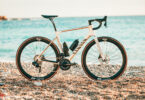Cycling and coffee go together like, well, coffee and cycling. It just works, right? The respective cultures are now so tightly interwoven that, for many of us at least, one wouldn’t be the same without the other. You’re probably in one of two camps: a cyclist who drinks coffee or a coffee lover who cycles. But what about the rare gems who are coffee roasters and kick-ass riders? That’s where Vertical Coffee come in.
Coffee – the seed from the cherries of the coffee plant that’s dried before being roasted, has become something the world craves. We go mad for it. Every week, there’s a new hype, proclamations of what the most fashionable coffee currently is, what machine you need, which blends are best and what extraction rate you should brew at.

A pour over with accurate scales to measure weight and timings for the coffee and water.
As much as we love this drink, it can feel slightly intimidating at times. Whether you take the snobbery or the science angle, coffee can become an endless rabbit hole – the good, the bad, the achingly hip and the downright pointless.

Simone Ernst and Denise Morf run Vertical Coffee Roasters from their home roastery in Central Switzerland.

Vertical is now synonymous with the world of elite sports in Switzerland.
That’s where Simone Ernst and Denise Morf of Vertical Coffee come in. They’re cyclists (real ones, with the tan lines, Strava segments and calf muscles to prove it) and coffee lovers. Their raison d’etre: to de-snobify coffee and open it up to everyone, especially athletes. When they saw how specialty coffee was taking off in nordic countries over a decade ago, the pair wanted in on the scene. Why shouldn’t they be the ones to introduce Switzerland (and now most of Europe) to the delights of specialty coffee and create a community of coffee-mad athletes while doing so?

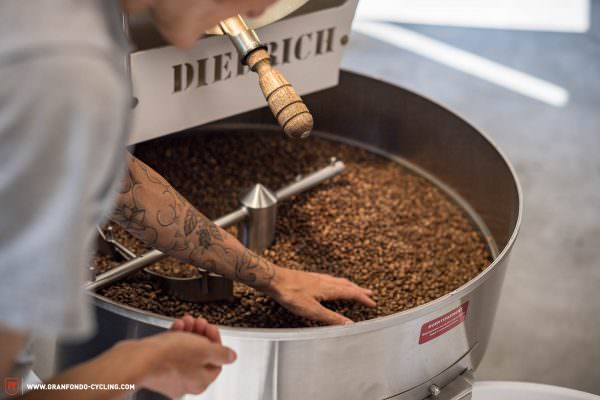
They did it. Not immediately but Vertical are now cemented in the psyche of almost all of Switzerland’s top bike riders, ski mountaineers and triathletes. Vertical have the mantra, “coffee with altitude”, which chimes with Simone and Denise’s sense of adventure. Indeed, we could write a whole article on just how active these two are. Suffice to say, their backstory includes a lonely-hearts-style advert to join the police, open-water diving for criminal activities and XC skiing competitions near the Arctic Circle (they would have been into Alpine skiing but the slopes were too crowded).
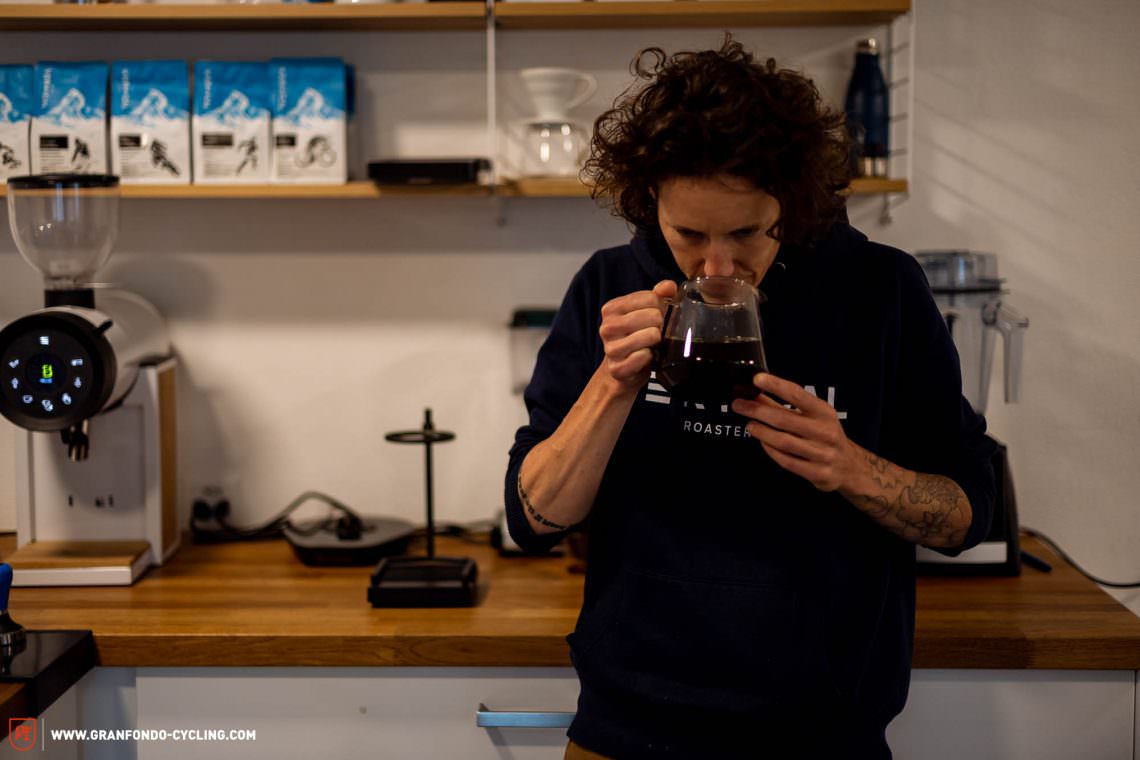
Simone: “There’s always a fist pump when we both come up with the same tasting notes on a roast.”
Speaking with a hint of a grin, Denise describes how they first cut their coffee teeth. “It was triathlons that properly got us into the green bean. Kona, 2007, when Simone was racing for the third time. We’d discovered this amazing coffee scene in Hawaii, and seeing this collision of sport and coffee amazed us.” Simone steps in to bashfully downplay her Ironman credentials, but all the more keen to talk coffee. “Back home, there was nothing but Starbucks. We loved what we saw in Hawaii so much that we figured we would import this brand’s beans and sell them to triathletes. The only thing was that people weren’t actually waiting for us back here. That was something we had to work on.”

Three-times Kona qualifier, Simone, wanted a job that meant she could be outside on her terms. Running Vertical from home and providing coffee at the nation’s biggest sports events has brought that dream to life.
The pair have always wanted to refute the idea of coffee being pretentious. “Some baristas hide behind their coffee and aren’t hospitable,” Denise admits. “There’s almost a veil over specialty coffee that makes people shy away from it, thinking it’s too complicated.” After selling that first imported batch of coffee, the pair, who at this point had realised that, “the police wasn’t their destination”, opened a specialty coffee shop in Zurich called Benzin & Koffein and began to think seriously about roasting their own. “Coffee is such a rabbit hole,” Denise laughs, “Simone threw herself into forums with strange people to find out more.” Luckily, Simone’s parents owned a fondue restaurant which was supplied by a small roastery outside of Zurich and they pointed their daughter towards it. It had a clunky, super old-fashioned machine which formed their introduction to roasting.
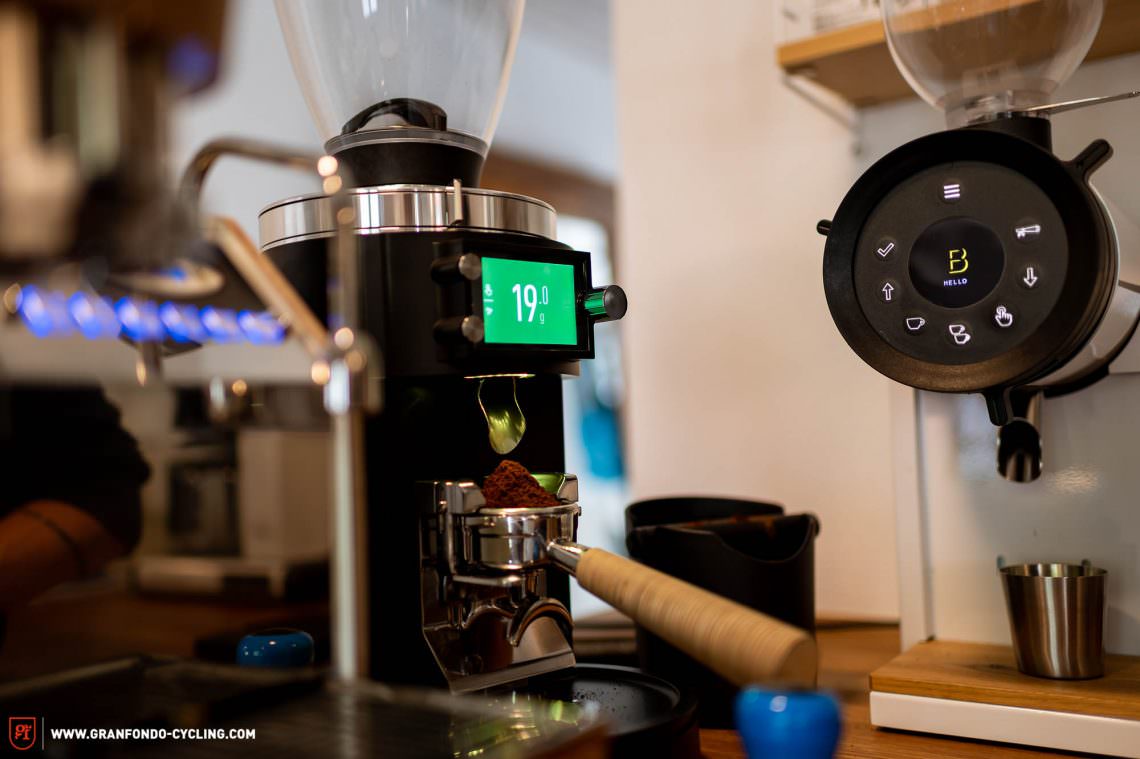
Bang on: a grinder that probably costs more than your bike. But you can’t put a price on a consistent and finely adjustable grind. #lifeistooshortforbadcoffee
“When I think back to those early days and how bad the coffee was, I can only laugh,” Simone’s shoulders heave in laughter. “The roaster was typical old-school Italian. He must have been a mechanic before he got into coffee. He forced the roast so hard, advising us to listen for the first crack, then the second one, then give it another 30 seconds and it’ll be good to go.” She gestures, clenching her fist and pushing it out from her chest to accentuate the darkness of the roast. “Our apartment was packed – one room full of bikes, one of coffee and one for sleeping. We had such an intense week working on our first blends, putting his mini-roaster on our balcony with its huge flame and consuming way too much caffeine to test the roasts. We’ve come a long way since then.” The pair laugh contagiously at their Dunning-Kruger-like naivety, where they’d displayed the same sort of faux expertise of which many bike newbies are guilty. In their defense, this was pre-2010 in a less-digitally connected world and they were working with a spreadsheet and writing down the roast temperature every 30 seconds. It was a far cry from the roasting software available today.
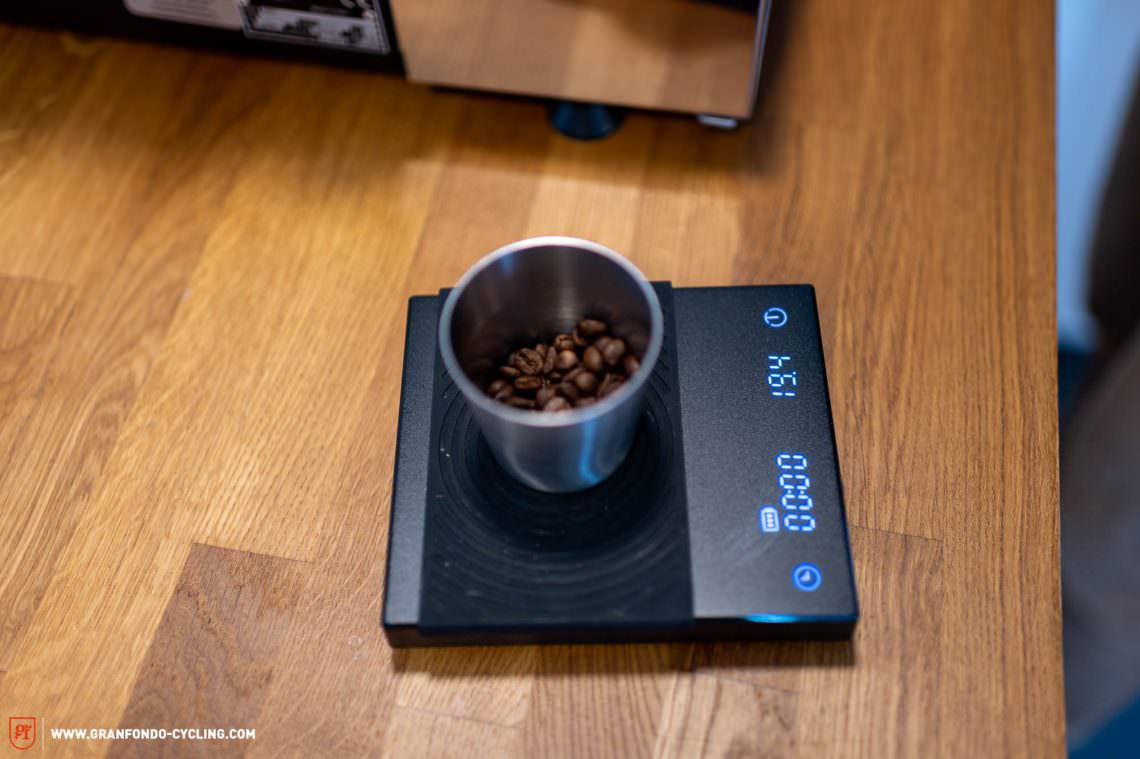
Getting the best brew is all about the details.

As complicated as the culture is, Vertical explain it in simple terms: a coffee bean is essentially cellulose that absorbs the flavours of the environment around it. The flavour that ultimately ends in your cup depends on where it comes from, how it is dried, processed, roasted and brewed. Roasting unlocks said flavour and aroma in the bean across a spectrum: the darker you roast, the deeper, more chocolatey the flavours, but the darker you go, the more you cover up the lighter, acidic flavours in the bean. That is why specialty coffee tends to be lighter roasted, allowing the quality and flavour of the bean to come out in your cup. Note: you can roast the heck out of bad beans to mask their lower quality, creating a burnt/roasted flavour instead of highlighting the characteristics of the bean (supermarkets, we’re looking at you). Welcome to the world of coffee!

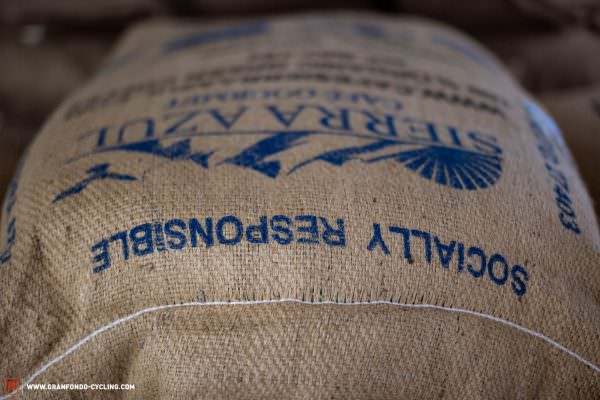
By now, the pair know all about how washing processes for beans in Ethiopia differ to countries in South America, whether it’s a wet or dry mill, done at source or elsewhere. They know how to spot good or bad beans, the effect of the wind when drying and timings when it comes to harvesting. It’s all incredibly nuanced, but the pair have spent the past decade dialling it in. And their roasts, enthusiasm and straight-speaking attitude have struck a chord with many athletes in central Europe, particularly in Switzerland, where Vertical is the key supplier for mountain bike riders, road riders, Yanick the Mechanic (of Nino Schurter fame) and Emma Pooley, to name just a few.

When you see this truck at an event, you know you’re in for some specialty coffee. We’ll take a flat white.
At virtually any national or international bike event in Switzerland, you’ll see Vertical’s distinctive blue-and-white van. Simone and Denise don’t just ride their bikes, they’re fans of the sport. They can tell you all about the racing, the athletes and their entourages (as they’re usually the ones queuing for coffee). The pandemic hit the pair’s social life (and events calendar) pretty hard, but they’ve just renewed the road tax for their van and are keen to get back out on the road.




Vertical Coffee’s two favourite machines take pride of place in the roastery.
In the midst of plans being made and adjusted, events cancelled or postponed, the one constant has been their weekly roasting day, followed by dispatching orders. And the other days of the week? If there’s no admin, they’re probably outside, most likely on their bikes. In an average year, they cover thousands of kilometres by bike and the pair feel awkwardly privileged to have reached a sort of utopia with their work-life balance. But no matter how far they ride, it’s fair to say that they don’t ever really escape coffee culture…

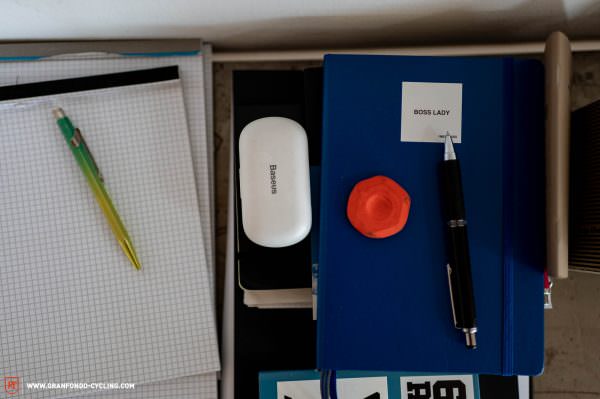
“It’s mad, we were riding in Italy a couple of weeks ago and I really wanted a cappuccino even though it was the afternoon. But even I was too intimidated to order one after that unspoken 11am cut-off!” Denise looks mortified. “That shows how over-complicated coffee has become. Add in the complexity of machines, methods, fine or coarse grinds, tamping… and before you know it, people might just turn off. It’s not always easy to know how much is design and how much is function, but essentially, all you need is good coffee, good water and you can’t go wrong. It all comes down to personal taste, so no one should be embarrassed to order a cappuccino late in the day.”


The best people to take on a ride if you’re looking for a killer mid-ride coffee.
Vertical’s Guide to marginal gains in Coffee
In this chapter, Simone and Denise have put together their tips for more coffee enjoyment. So prick up your ears for the pros! They say:
Stick to the basics. Try new coffees. It takes a while to figure out what you like but it’s well worth investing in some bags of specialty coffee. You’ve probably surely spent money less wisely before and you can always give it away if you don’t like it.

Note to self: learn how to cup like a pro. (Taste, don’t drink)

Don’t get lost in the marginal gains – all the gadgets. Like any industry, people will always try to sell you things you don’t need. Focus on consistency, learn how different grinds affect the flavour of the same coffee and work towards finding what tastes best to you.

Fine or coarse? It’s an art in itself. Vertical’s tip: invest more in your grinder than your espresso machine because good coffee comes from the perfect grind.

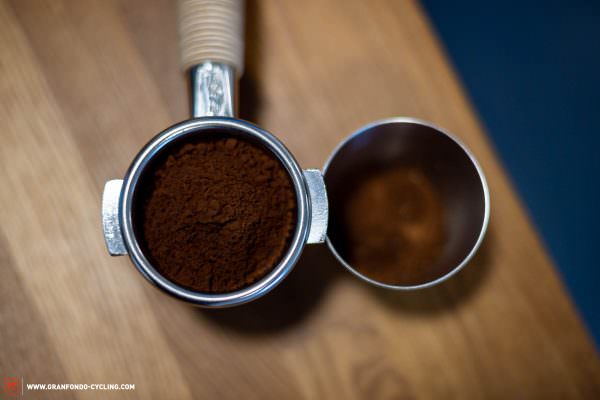
Make sure that you know how your brewing method works. Learn the fundamentals of extraction to truly understand how to get the most from the beans you’ve bought. There are three T’s that you can control depending on your method: time, temperature and turbulence. Once you understand which variable has which effect, you can adjust according to your taste.
Make sure you clean your machine. There’s no point spending any money if it’s black inside. Imagine your chain is dirty or worn: what benefit would you get from CeramicSpeed parts?

Because time it is one of the three Ts.
The three Ts, as explained by Vertical
TIME How long is the water in contact with the coffee for?
Vertical’s explanation: As a starting point you need to think about what type of coffee roast you need for what sort of coffee you’re making. If the contact time with the water is under a minute, pick an espresso roast. If it is more go for a filter roast. Gravity determines the time when making a filter coffee but with an Aeropress you can choose to let it steep for longer. Using a Bialetti with an espresso roast? Pre-boil your water to ensure the extraction time doesn’t get unnecessarily long. Pour over? The slower you go, the darker the coffee, the deeper the flavours that you extract, but with that you risk covering the lighter notes.
TEMPERATURE How hot is the water?
Vertical’s explanation: After time, focus on temperature. Hotter water tends to extract more from the bean, meaning that if you make a very dark (read: burnt) flavoured roast coffee with boiling water, you’ll lose the more delicate flavours. Equally if your water is not hot enough, you will lack the full rich body possible with coffee. With filter coffee, the flavours are more volatile when it’s hot, so test out different temperatures to discover different flavour attributes.

TURBULENCE No, not the need to fasten your safety belt during a flight, we’re talking about agitated water.
Vertical’s explanation: You’ve probably seen the barista who pours their water into their Chemex in a certain way, right? That is turbulence in its most visible sense. The more you move the grounds in the water the more will be extracted from them. Either by stirring, pouring from a height or pouring more forcefully. Again, the key takeaway is that the more that is extracted, the deeper the flavour you will get from your coffee, potentially masking those lighter notes.
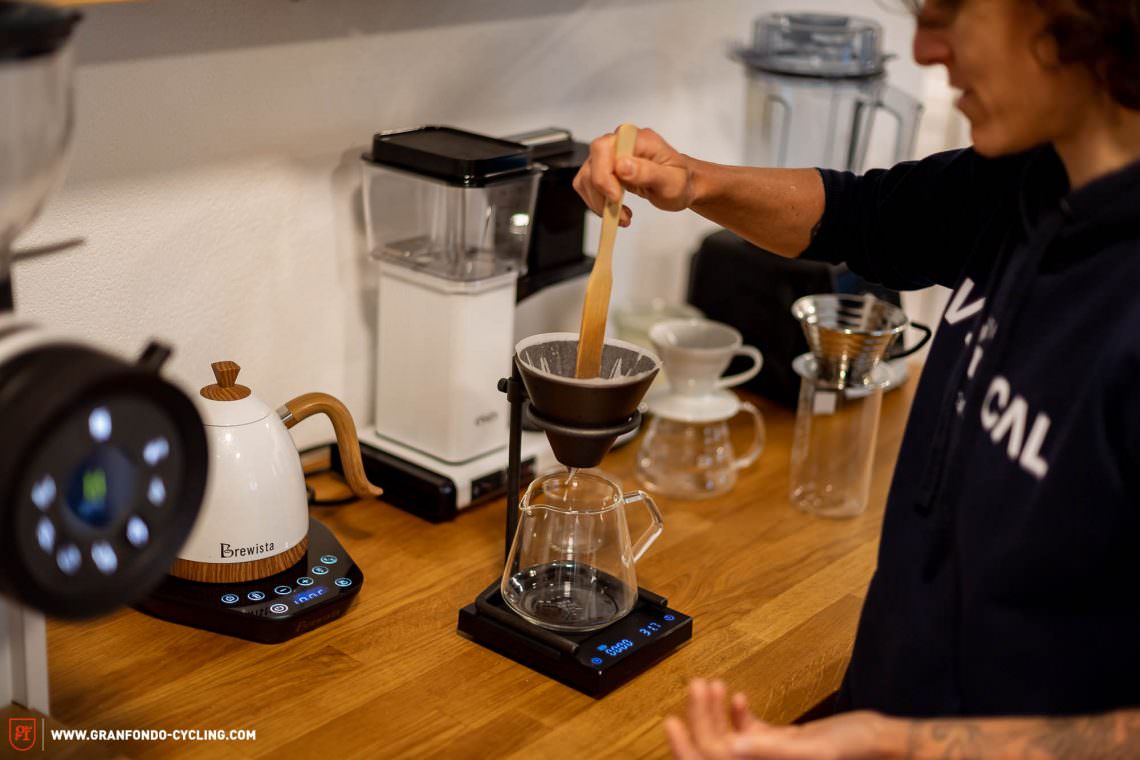
Talking of notes, Simone and Denise were keen to stress that coffee is a matter of taste, so the idea behind thinking about these three basic variables is that you can adjust each one individually to refine what you brew at home. Whether that’s more towards the heavier and bolder flavours or more towards the acidic notes depends on your preference, and it is this that should be at the centre of everything that you do.
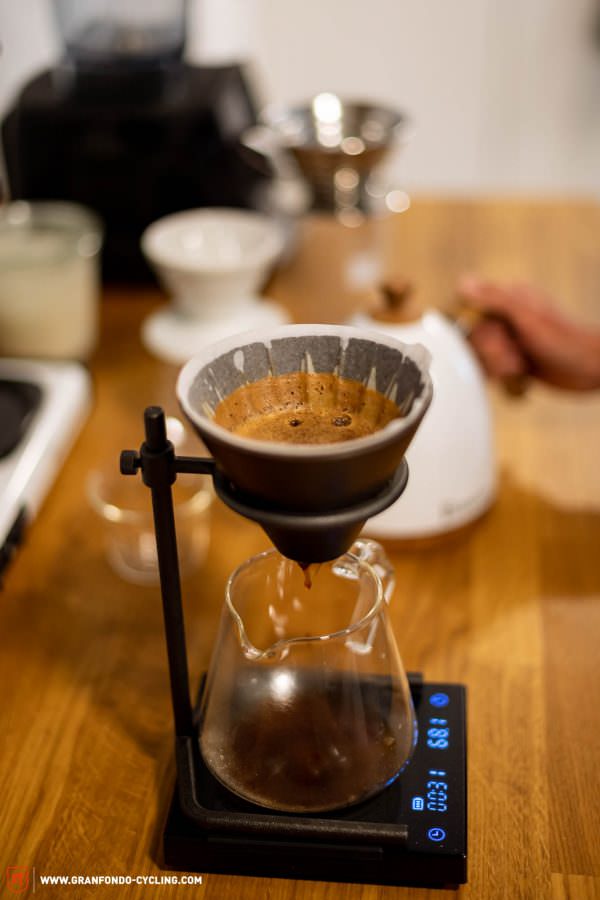

More coffee geekery: Why is it that certain espresso machines cost more than a top of the range bike? Because they have a dual boiler within them that allows you to brew multiple coffees without a drop in temperature and thus a change in flavour. Is this needed? If you’re running a bar, most probably. If not, wait for your more affordable machine to get back up to temperature if you’re making multiple cups.
Final coffee geekery note: Other than bean choice and roast, water is key too. That is why a top tip from Vertical is to always use filter water at home, especially if you prefer lighter coffee roasts. When you’re out in the wilds making coffee, go for a less delicate blend, so that if you have heavier, more mineral-dense water, you don’t risk losing the fruity notes.

If Angela Merkel also likes coffee from the AeroPress? Denise and Simone, at least, are fans of this method of brewing. And yes, there are actually championships for it. Are you already training hard?

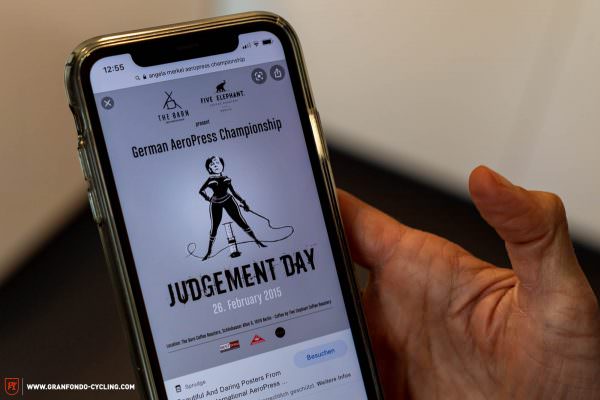
At this point in the interview, GRAN FONDO had already necked five coffees and discovered (to the excitement of the Supersapiens’ blood glucose monitor (click here for the review)) that pea milk makes a seriously delectable flat white. When Simone and Denise offer us a decaf, we’re all for it.
Over the next cup, Denise tells of a day when there was significantly less choice: “A couple of weeks ago someone dropped by the roastery from the other side of Switzerland. He’d bought from us regularly, seen us on Instagram and wanted to have a coffee on his ride. Unfortunately it was Monday, roast day, and the espresso machines were switched off. All we had on the go was a flask of filter coffee that we’d made that morning. He looked devastated, but honestly…” Denise is very convincing, “The simplicity of filter coffee is where it’s at. It’s like going for a gravel ride, the most refreshing kind of ride when you know you can take whatever route you want and you’ve got a beautiful Stelbel with an Eagle drivetrain to get you through whatever the route throws at you.”
Coffee-making essentials for cyclists, according to Simone and Denise
Aeropress
The method of choice for bike rides. 12 g coffee/200 l water. If you’re preparing for two riders, make an Aeropress Bypass. Make more concentrated coffee, grind it finer or steep it for longer, then split and top up with hot water. No scales? Eyeball the amount. Filter roast is recommended for more contact time with the water. Vertical’s verdict: “You can influence every variable individually: how long you let it steep (time), hot or less hot water (temperature), whether you stir the coffee a lot or a little (turbulence).”

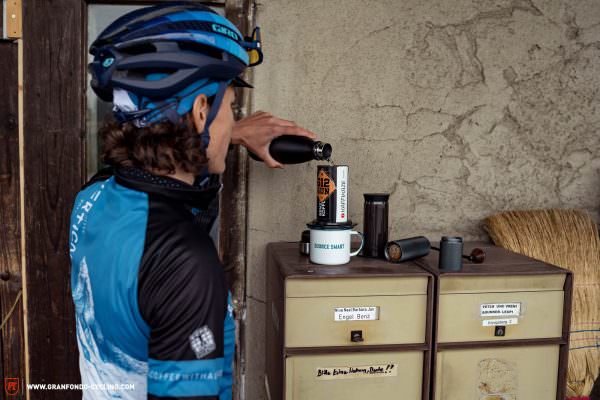
Tip #1 choose a hand-grinder that can slot handily into your Aeropress.
Tip #2 take a thermos of hot water in your bottle cage. Don’t underestimate the benefits of “good” water – use filtered water whenever possible when making coffee as hard water will kill the flavour. Minerals are needed to extract the coffee but it’s a delicate balance of certain minerals in certain ratios that make the difference. At competitions, top brewers opt for deionized water and add exact amounts of minerals themselves. Vertical’s verdict: “Water is key but the idea of creating the perfect brewing water is insanity.”
Espresso
The king of coffee, the one that tests your barista skills to the limit and allows you to splash out on some fun toys. Call this the go-to method for many, make sure you know your machine and grinder well to get the best out of your cup. Double espresso is 19–20 g, with an extraction of 38–40 g (ratio 1:2). Vertical’s verdict: “The centerpiece of coffee, with so many possible drink options. We love it, but it takes time to master this one – the smallest changes to your grind setting has the greatest impact here. But you’re not really going to be able to take this one on the road with you. Save it for your pre/post ride coffee.”

Manual pour over
When done at home, measure it out: 30 g coffee/500 g water, 3.5/4 minutes of total pour time (the darker it is, the more you’ve extracted). Begin with 60g water, let it bloom, then ensure all the grounds are wetted evenly to get an even extraction by giving it a swirl. Adjust turbulence with the height of your kettle – the higher it is, the more turbulent. The result will be even better if you do it with a gooseneck. The goose neck? That’s for a nice, even flow. Vertical’s verdict: “A good way to make two reasonably sized cups of coffee, but not ideal during rides as there’s glassware involved.”

Cold brew
The fridge staple for summer. Use a lighter roast. 100 g coffee/1 litre water. Begin by blooming 20 g coffee with 200 g water, wet evenly, count 30 seconds then add cold water. Store airtight in the fridge for 24 hours before taking out the coffee grinds. Vertical verdict: “One where you have to get your measurements right, because you can risk a very woody flavoured coffee due to the hyper-long brewing time.”

Filter coffee from the machine
The morning method of choice, especially on roasting days. 60–65 g coffee/1 litre. Vertical’s verdict: “So much easier to perceive the flavours. You don’t have to worry what milk to do. We look at this like the gravel riding of the coffee world, relaxed but full of flavour, one that you’ll keep coming back to.”
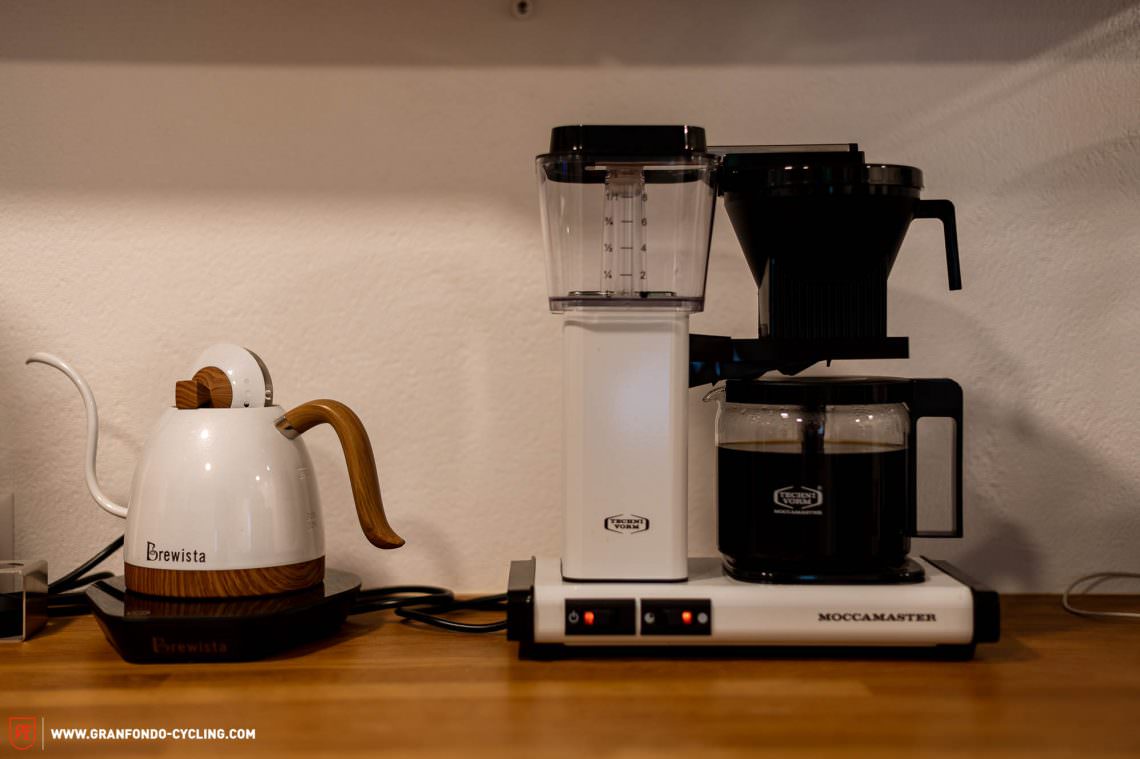
Mid-ride filter
A collapsable camping filter. Don’t forget your paper filter, and make sure it’s kept somewhere dry. Go with the filter coffee ratio of 60 g coffee/1 litre water, but downscale for a one- or two-person job. Vertical’s verdict: “More complicated to control because you’ll be pouring from whatever utensil you’ve heated your water in, which means you may alter turbulence and extraction. A good one to test your pouring skills though.”

Syphon
The chemistry experiment. This is one for the real coffee nerds. This is such a complicated method we will leave you to check out the pictures. Vertical’s verdict: “Looks cool and is an impressive trick to have up the barista sleeve – one to try at least once.”

Aeropress over ice
The choice for summer. Exactly what the name suggests. All the steps of a Bypass Aeropress with the water used to top up the quantity already frozen, cooling the coffee for those hotter days. Vertical’s verdict: “Quicker than a cold brew and has the potential to maintain the lighter flavours in the coffee because brewing time is the same as a regular Aeropress.”
Moka pot
The classic Italian. Gives a rich thick coffee and is perfect for on-ride stops. You have two factors that affect the choice of roast you use. Pre-heating the water will speed the process up, meaning an espresso roast is the best option because contact time with the water is reduced. If you are going from cold then opt for a filter roast due to the longer contact time with the water. Vertical’s verdict: “Good on-the-road coffee and you can add more water to this one post brewing for a less powerful coffee.”

French press
Use the coarsest grind possible. Brew time depends on your preference, 4 minutes recommended with standard filter coffee ratio of 60 g coffee/1 litre water. Adjust the amounts depending on the size of your French press. Vertical’s verdict: “A nice method for on-ride coffee if you opt for a lightweight, metal camping-style French press. With the right method, you can get a lot of flavour out of this one.”
Conclusion
Did you get through the whole text without making a coffee on the side? Then hats off to your self-control! If you’re still looking for the right beans: Simone and Denise’s bean shop is located in front of the house where they live and work in Unterlunkhofen – and of course online. But always remember: the best coffee is the one that tastes best. And along the way, it’s worth experimenting a bit and maybe stumbe across something really great!
More information? You can find retailers near you on the Vertical website, as well as online ordering options. Denise and Simone deliver almost worldwide. If you have any questions, you can reach them on Instagram.
Did you enjoy this article? If so, we would be stoked if you decide to support us with a monthly contribution. By becoming a supporter of GRAN FONDO, you will help secure a sustainable future for high-quality cycling journalism. Click here to learn more.
Words & Photos: Phil Gale





